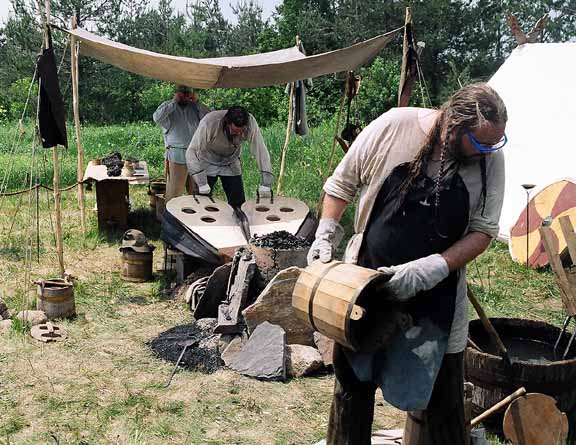Little Newsham, County Durham, England
www.littlenewshamforge.com

" Towards the end of my four years at art college, the thought entered my head that it might be fun to be a blacksmith. I really wanted to serve an apprenticeship with a blacksmith, but in early 1970`s England they were very thin on the ground. There was no BABA or ABANA, no internet, no way of contacting other like minded people. I was offered a forge in a lovely old farming village in the north east of England and opened up for business in 1976, armed with two books by Fritz Kuhn and copies of the Cosira books : "A Blacksmith Craft," and "Wrought Ironwork". Shortly afterwards, I had a couple of short visits from a Cosira instructor, Ron Brown, who arrived with a bag full of ram`s heads, snails and leaves of all descriptions. This opened my eyes to possibilities that I had previously not considered; decorative features did not have to be scrolls! The founding of The British artist Blacksmiths Association in 1978 had a major impact on the work that I was designing and making. I was able to meet and see the work of craftsmen from all over the UK who had been established for years, producing amazing shapes of all descriptions in forged metal. This was a big eye opener for me, I had to go out and find a power hammer, to enable me to work bigger sections, and quicker!
" I do prefer architectural scale work,with as many forged elements in it as possible, so it will be fun to make. It`s a good feeling to have a pile of forgings on the floor at the end of the day. I don`t buy components from catalogues, for me it would be wrong to include pieces designed and made by others in my work, no matter how good the quality or how cheap. Having said that,for some jobs we do have blanks either laser cut or gas profiled to be forged into finished shapes by us. I continuously try to come up with new ideas, it`s not always easy,as there is so many clever blacksmiths out there now, and I have designed so much myself over the years, that it is difficult to come up with new forms.
" I try to make the work that we do as varied as possible, although there is no getting away from natural forms, is there? We love rivetted gates, with mortice and tenon joints,whether large or small. Sometimes these have traditional forms but more often with a design that hopefully will stand out as being different. Forge welding is a process I really enjoy, and use as much as possible. I think that most people regard me as a craftsman that will only work traditionally, and while I do prefer to work in this way, I do take on sculptural projects that by the size and the nature of the design, make it necessary to use modern methods as well. "

Barley Hand Rails
These rather more contemporary features are to be found on a cottage that was formerly a malt house. They feature heads of Barley and germinating grains.
"We are lucky in having a good client , a property developer who keeps coming back for more work,and gives me a pretty free hand with the design.This is an old cottage he owns which used to be a malthouse, so I tried to incorporate this aspect of it`s history. All the elements are forged but the assembly is a fabrication job.If I remember correctly,the grains are swaged from 70mm round, the tools made from a pattern turned on our old lathe.We make a lot of these tools, you can reproduce almost any shape of a circular section."

Table Candle Holders
A pair of candleholders showing how plant forms can be used with good effect in forged Metalwork.
"...a rare commission for us these days. Although we make quite a lot of candleholders for churches, these were for a private house. It makes a welcome change to do small scale work now and again, I sometimes think we don`t do enough hand forging..."

Brancepeth Screen
A forged steel screen, backed by toughened glass, in the ancient church of St. Brandon near Durham.
" This piece is in a church dating from the 11th century. It is a screen glazed with toughened glass to provide a quiet room in the church.It was far too big to fit through the church door,so a window had to be taken out ,and the 800 kg screen passed through on edge ( with 75 mm clearance).It was a delicate operation. "
Also on Brian's web site: An extensive portfolio of his past work, primarily architectural pieces. On the front page is a slide show feature that shows concept drawings which fade into an image of the competed works. On the 'Image Gallery' are many of his (high quality!) design drawings.










